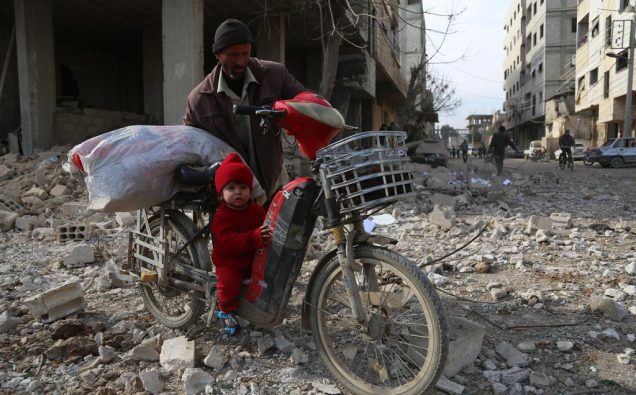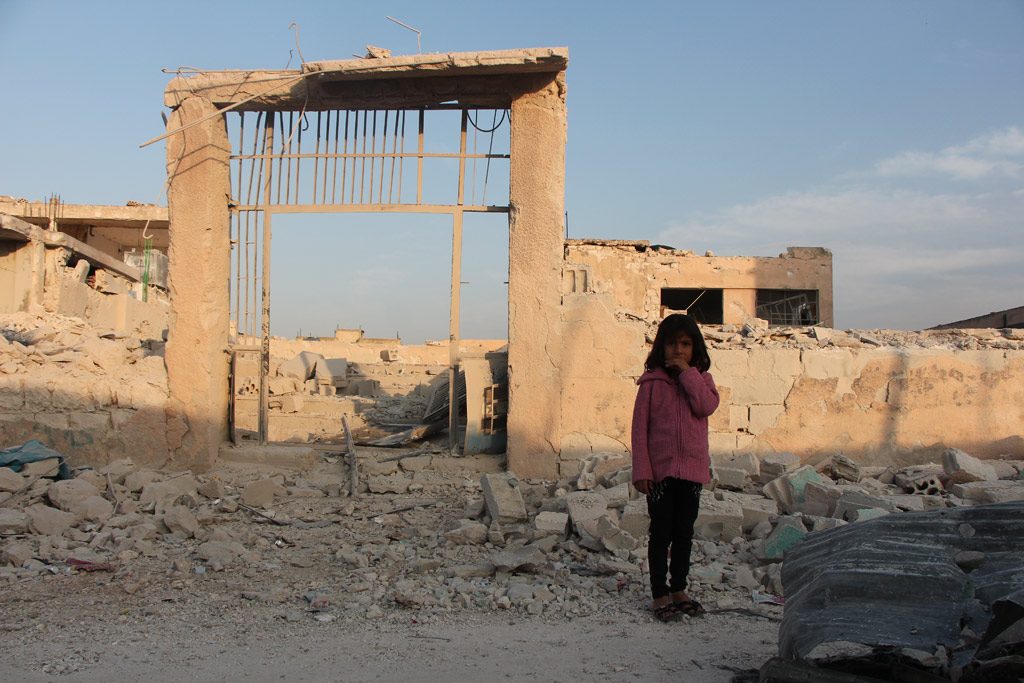
Ru’a, 18 months, rides on her grandfather’s motorbike as he drags it across Mesraba in East Ghouta, Syria. Photo:NICEF/2018/Amer Almohibany
After one of the worst years for children in the ongoing Middle Eastern conflicts, 2018 has seen a brutal start for Syrian children.
The UN has confirmed that more than 30 Syrian children have been killed in Syria’s East Ghouta in the first two weeks of the new year.
An estimated 200,000 children have been trapped under siege in East Ghouta since 2013, according to a UNICEF official.
The kids have been victims of violence from all sides including the ISIS but Bashar al Assad’s has been blamed for killing a big number of children in aerial strikes in the seven-year-old conflict.
“At a time when most parents are filled with the New Year’s hope for their children’s future, mothers and fathers in Syria are left grieving for the children they have lost,” said Fran Equiza, UNICEF Representative in Syria.
“It is shameful that nearly seven years into the conflict, a war on children continues while the world watches. Millions of children across Syria and in neighbouring countries have suffered the devastating consequences of unabating levels of violence in several parts of the country,” he added.
UNICEF received information from inside East Ghouta that people are taking shelter underground in fear for their lives.

A seven-year-old child stands in front of her damaged school in Idleb, Syria. October 2016. Photo: UNICEF (File Photo)
Two medical facilities came under attack in the past days in East Ghouta, and most health centres had to close because of the violence. Schools have been reportedly closed in and around East Ghouta at a time when children elsewhere in Syria are sitting for their mid-term exams.
“While we saw a small glimmer of hope at the end of last year with the evacuation of 17 children in urgent need of medical attention, increased violence in and around east Ghouta turned hope into despair for the remaining 120 children who continue to suffer in silence waiting for urgent medical evacuation,” Mr. Equiza said.
The UNICEF also reports that in Idlib, to the northwest of the country, heavy violence reportedly killed and injured scores of children and women and displaced an estimated 100,000 civilians in the past few weeks. The maternity and paediatric hospital in Ma’arrat An Nu’man was attacked three times taking it out of service and killing at least one patient and two medical staff.
“We must be able to reach children in need of humanitarian assistance, urgently and without restrictions, wherever they are in Syria. The various parties to the conflict can make that happen by immediately allowing humanitarian workers to reach them with life-saving assistance,” he said.
2017 was a nightmare for Middle Eastern children.
“Children are being targeted and exposed to attacks and brutal violence in their homes, schools and playgrounds,” Manuel Fontaine, UNICEF Director of Emergency Programmes said in December 2017.
“As these attacks continue year after year, we cannot become numb. Such brutality cannot be the new normal.”
In conflicts around the world, children have become front line targets, used as human shields, killed, maimed and recruited to fight. Rape, forced marriage, abduction and enslavement have become standard tactics in conflicts from Iraq, Syria and Yemen, to Nigeria, South Sudan and Myanmar.
In some contexts, children abducted by extremist groups experience abuse yet again upon release when they are detained by security forces. Millions more children are paying an indirect price for these conflicts, suffering from malnutrition, disease and trauma as basic services – including access to food, water, sanitation and health – are denied, damaged or destroyed in the fighting.
Here is a list of places with most children casualties but the statistics would never be able to tell the pain of their loss.
– In Afghanistan, almost 700 children were killed in the first 9 months of the year.
– In the Central African Republic, after months of renewed fighting, a dramatic increase in violence saw children being killed, raped, abducted and recruited by armed groups.
– In the Kasai region of the Democratic Republic of the Congo, violence has driven 850,000 children from their homes, while more than 200 health centres and 400 schools were attacked. An estimated 350,000 children have suffered from severe acute malnutrition.
– In northeast Nigeria and Cameroon, Boko Haram has forced at least 135 children to act as suicide bombers, almost five times the number in 2016.
– In Iraq and Syria, children have reportedly been used as human shields, trapped under siege, targeted by snipers and lived through intense bombardment and violence.
– In Myanmar, Rohingya children suffered and witnessed shocking and widespread violence as they were attacked and driven from their homes in Rakhine state; while children in remote border areas of Kachin, Shan, and Kayin states continued to suffer the consequences of ongoing tensions between the Myanmar Armed Forces and various ethnic armed groups.
– In South Sudan, where conflict and a collapsing economy led to a famine declaration in parts of the country, more than 19,000 children have been recruited into armed forces and armed groups, and over 2,300 children have been killed or injured since the conflict first erupted in December 2013.
– In Somalia, 1,740 cases of child recruitment were reported in the first 10 months of 2017.
– In Yemen, nearly 1,000 days of fighting left at least 5,000 children dead or injured, according to verified data, with actual numbers expected to be much higher. More than 11 million children need humanitarian assistance. Out of 1.8 million children suffering from malnutrition, 385,000 are severely malnourished and at risk of death if not urgently treated.
– In eastern Ukraine, 220,000 children lived under constant threat of mines and other explosive remnants of war due to the 500 kilometer ‘contact line’ – the strip of land where fighting is most severe – becoming one of the most mine-contaminated places on earth.

















